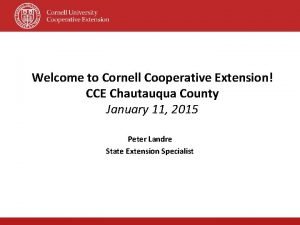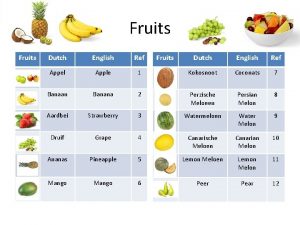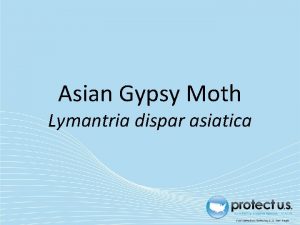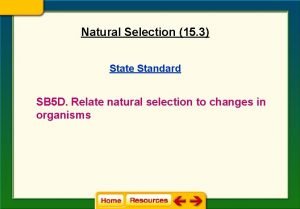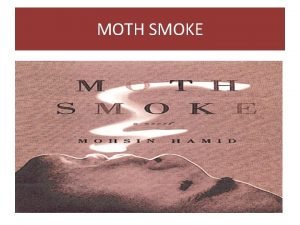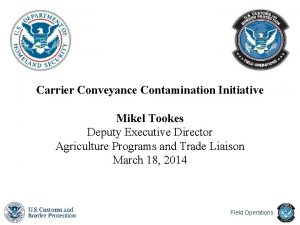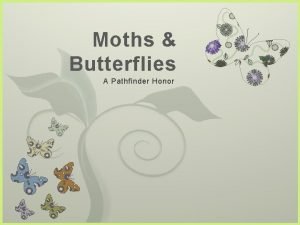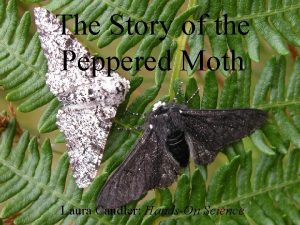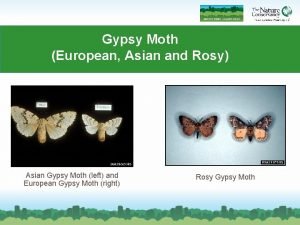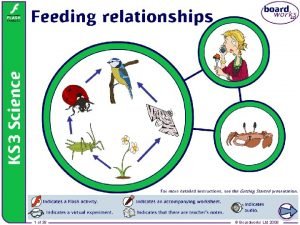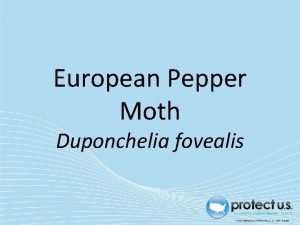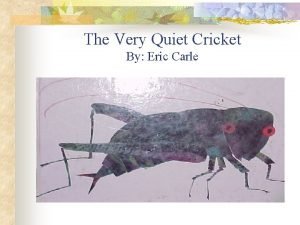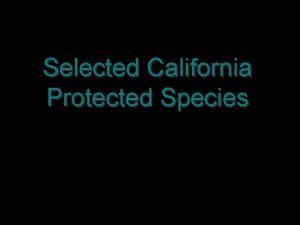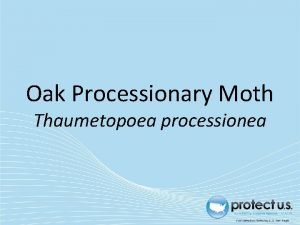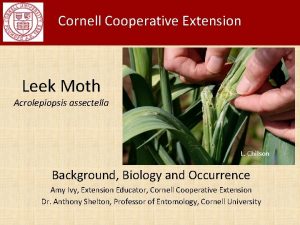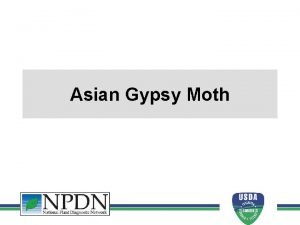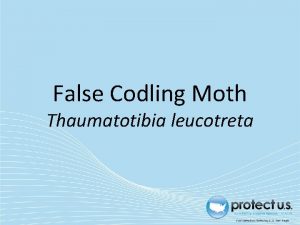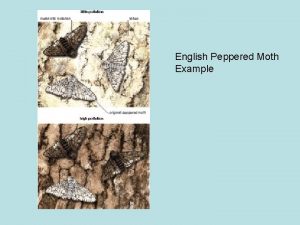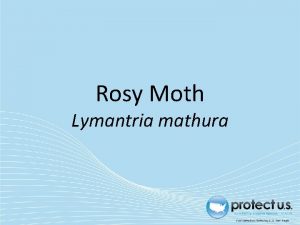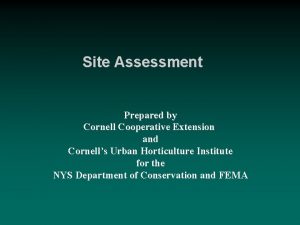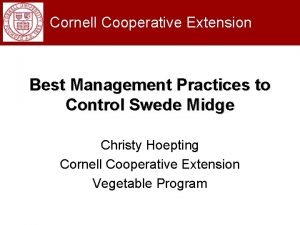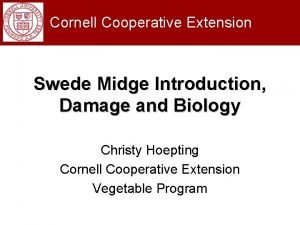Cornell Cooperative Extension Leek Moth Acrolepiopsis assectella L
























- Slides: 24

Cornell Cooperative Extension Leek Moth Acrolepiopsis assectella L. Chilson Background, Biology and Occurrence Amy Ivy, Extension Educator, Cornell Cooperative Extension

Host Crops • All members of the Allium (onion) family – – – – Onions Leeks Garlic Chives Shallots Wild alliums About 60 species of Allium in the use, wild and cultivated

Damage • • Feeds on foliage Reduces yield Can lessen storage life Multiple generations increase in damage

Where did leek moth come from? • Well established in Asia, Africa and Europe for centuries • 1993 - came from Europe to Canada (eastern Ontario) • 2001 -02 localized sightings • 2007 more sightings in southern Ontario

How do they spread? • 2009 - first sighting in the continental US in Plattsburgh, NY (Clinton County) • 2010 - confirmed in St. Lawrence County • 2011 – more sites found in St. Lawrence County, one new site in Clinton County, NY • Adults can fly 100 -200 meters • Also carried on weather fronts even farther • Onion starter plants can be infested and transported

Current Distribution as of Nov 2018

Life Cycles - Generations • Late April - early May – overwintered adults emerge, lay eggs for up to 28 days • Mid-late June – first generation adults emerge • Early August – second generation adults emerge (possibly) Depending on the weather and temperatures:

Adult Identification • Adult moths • Reddish brown to gray in color • White triangle shaped spot on folded wings • Nocturnal 0. 25 inch Copyright Robin Barfoot

Life Cycle - Eggs • Eggs are laid on lower leaf surfaces • Tiny and very hard to see • Laid when temperatures are 50 -55 ° F • Hatch in 4 -11 days

Life Cycle - Larvae • Larvae are slender, yellow-green • First instar hard to see • Grow to ~ 1 inch long in final stage • 8 tiny dark spots on each body segment • 11 -23 days as larvae, depending on temperature

Life Cycle – Pupae • Look for pupae on nearby leaves and structures • 12 -21 days as pupae • Adults emerge and live ~ 23 days

How to find Leek Moth on onions • Look for windowpaning on onion leaves • Split leaf open and look for frass and debris • Larva may or may not be present – debris is telltale evidence

How to find Leek Moth on garlic • In June, look first at scapes if hardneck type garlic • Then look at newest leaves • Unfold leaves and look for debris and larvae

How to find Leek Moth on leeks • Look at newest leaves • Look for windowpaning, holes, debris L. Chilson

Leek Moth Look-alike Damage: Salt Marsh Caterpillar • Windowpane type damage, but on outside of onion leaves • Caterpillar is hairy and more robust than leek moth • Found on onions and leeks in 2011

Leek Moth Look-alike Damage: Thrips and Botrytis Leaf Blight on Onions • White patches on leaves • Split leaves open, clean inside – no frass or debris C. Hoepting

Management - Prevention • Know your source – Check packs of onion seedlings carefully – But even with clean plants, adults can fly or be blown in • Rotate to a new location

Management - Prevention • Use rowcover immediately after planting in new location to prevent egg laying • Moths are nocturnal, so rowcover can be removed during the day for weeding and replaced in the evening

Management - Control • Garlic – diligent removal of damaged scapes may help by destroying larvae there • Sprays – 5 have a 2 ee special label in 2011 • Efficacy trials in lab and in field

• Cultural control - Row cover • Biological control - Diadromus pulchellus (Mason et al. 2013) 20% control in garlic in Canada • • Chemical control - Warrior ll - Radiant SC - Lannate - Entrust - Dipel - Foliar application of Steinernema feltiae (Garcia del Pino & Morton 2008) • OK on garlic and excellent on leeks, but not on onions

Management - Control • Organic sprays don’t move through tissue well, most need to contact larvae directly • Larvae are protected inside onion leaves, or inside folded garlic and leek leaves • Conventional sprays can be effective

Management - Horizons • Natural enemies • In Europe, a number of predators, parasites and pathogens are known to attack the larvae and pupae of the leek moth • Currently, researchers in Canada are evaluating North American species that may offer control, as well as European biological control candidates, for release in Canada

Acknowledgment Pest Management Alternatives Program Grant 2013 -34381 -21310 Research support: Michael Bolton Jordi Llorens Calveras Alyssa Collins Devan George Yanyan Guo Tim Harvey-Samuel Paul Hetzler Amy Ivy Special thanks to: Bittersweet Farm Cross Island Farms Xiaowei Li Daniel Olmstead Lindsey Pashaw Ensi Shao Jinda Wang & Master Gardeners Masanori Seto – lead researcher Tony Shelton - Professor Kent Family Growers Rehoboth Homestead

Cornell Cooperative Extension For More Information https: //nysipm. cornell. edu/agriculture/vegeta bles/leek-moth-information-center/ Elisabeth Hodgdon Cornell Cooperative Extension Eastern NY Commercial Horticulture Program Plattsburgh, NY eh 528@cornell. edu
 Cornell cooperative extension schenectady
Cornell cooperative extension schenectady Cce chautauqua
Cce chautauqua Oklahoma cooperative extension service
Oklahoma cooperative extension service Tim leek
Tim leek Homophones of sixty minutes
Homophones of sixty minutes Wales symbols
Wales symbols Botanical name of leek
Botanical name of leek Netherlands fruits
Netherlands fruits Wendy brusca photography
Wendy brusca photography Danielle leek
Danielle leek Line extension vs brand extension
Line extension vs brand extension Moth
Moth Gypsy moth caterpillar
Gypsy moth caterpillar Adaptive radiation
Adaptive radiation Geologic time scale drawing
Geologic time scale drawing Moth smoke sparknotes
Moth smoke sparknotes Asian gypsy moth vessel inspection
Asian gypsy moth vessel inspection Moths and butterflies pathfinder honor
Moths and butterflies pathfinder honor Moth black and white
Moth black and white Gypsy moth
Gypsy moth Name the producer in the food chain.
Name the producer in the food chain. European pepper moth
European pepper moth Eric carle cicada
Eric carle cicada Kern primrose sphinx moth
Kern primrose sphinx moth Oak processionary moth life cycle
Oak processionary moth life cycle

